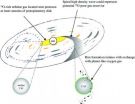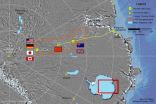(Press-News.org) Scientists have performed a micro-probe analysis of the core and outer layers of a pea-sized piece of a meteorite some 4.57 billion years old to reconstruct the history of its formation, providing the first evidence that dust particles like this one experienced wildly varying environments during the planet-forming years of our solar system.
The researchers interpret these findings as evidence that dust grains traveled over large distances as the swirling protoplanetary nebula condensed into planets. The single dust grain they studied appears to have formed in the hot environment of the sun, may have been thrown out of the plane of the solar system to fall back into the asteroid belt, and eventually recirculated back to the sun.
This odyssey is consistent with some theories about how dust grains formed in the early protoplanetary nebula, or propylid, eventually seeding the formation of planets.
"This has implications for how our solar system and possibly other solar systems formed and how they evolved," said Justin I. Simon, a former University of California, Berkeley, post-doctoral fellow who led the research. "There are a number of astrophysical models that attempt to explain the dynamics of planet formation in a protoplanetary disk, but they all have to explain the signature we find in this meteorite."
"Justin showed not only that this dust grain moved around the solar system over quite large distances, but that it had seen the gamut of possible places it could have been in the solar system," said Donald J. DePaolo, UC Berkeley professor of earth and planetary science and director of the Center for Isotope Geochemistry.
Simon, now a researcher with the Astromaterials Research Office at NASA's Johnson Space Center in Houston, Texas, along with DePaolo and colleagues at Lawrence Livermore National Laboratory (LLNL) and the University of Chicago report their findings in the March 4 issue of the journal Science.
Meteorites have puzzled space scientists for more than 100 years because they contain minerals that could only form in cold environments, as well as minerals that have been altered by hot environments. Carbonaceous chondrites, in particular, contain millimeter-sized chondrules and up to centimeter-sized CAIs (calcium-aluminum-rich inclusions) that were once heated to the melting point and later welded together with cold space dust.
"These primitive meteorites are like time capsules, containing the most primitive materials in our solar system," Simon said. "CAIs are some of the most interesting meteorite components. They recorded the history of the solar system before any of the planets formed, and were the first solids to condense out of the gaseous nebula surrounding our protosun."
Perhaps the most popular theory explaining the composition of chrondrules and CAIs is the so-called X-wind theory propounded by former UC Berkeley astronomer Frank Shu. Shu depicted the early protoplanetary disk as a washing machine, with the sun's powerful magnetic fields churning the gas and dust and tossing dust grains formed near the sun out of the disk.
Once expelled from the disk, the grains were pushed outward to fall like rain into the outer solar system. These grains, both flash-heated chondrules and slowly heated CAIs, were eventually incorporated along with unheated dust into asteroids and planets.
"There are problems with the details of this model, but it is a useful framework for trying to understand how material originally formed near the sun can end up out in the asteroid belt," said cosmochemist and coauthor Ian D. Hutcheon, deputy director of LLNL's Glenn T. Seaborg Institute.
Competing theories account for the composition of meteorites by moving dust from the inner solar system to the outer solar system without exiting the plane of the disk.
Simon teamed up with Hutcheon to use a relatively new ion microprobe called NanoSIMS (secondary ion mass spectrometer) to sample oxygen isotope composition in a CAI with approximately 2-micron resolution, about one-quarter the diameter of a red blood cell. Because the relative abundance of oxygen isotopes varied in the protoplanetary disk, it is possible to pinpoint where a mineral formed based on the relative abundances of the isotopes oxygen-16 (16O) and oxygen-17 (17O).
"NanoSIMS made this study possible by enabling us to look at the isotopic composition of oxygen on a very small scale," said Hutcheon. This contrasts with past studies of the isotopic composition of CAIs, which involved sampling over a much larger area.
Simon chose a pea-sized CAI – named for the high abundances of calcium and aluminum – from the Allende meteorite, the largest carbonaceous chondrite ever found on Earth. Estimated to have been the size of a car, it broke up as it fell through the atmosphere in 1969, showering the ground in Chichuahua, Mexico, with hundreds of pieces, many collected for subsequent study.
"I chose the Allende CAI because most of what we know about CAIs has come from the Allende meteorite, and therefore any record that I found would likely reflect the histories of CAIs in general," he said.
After cross-sectioning the small CAI, Simon and Hutcheon probed its core and four distinct mineral layers that had formed along the rim of the core like layers of an onion.
They found that the abundance of 17O increased outward from the center of the core, suggesting that the CAI originally formed in the inner solar system, where 16O was more abundant, but later moved farther from the sun, where the CAI's outer layers lost 16O to the surrounding 16O-poor gas.
They were surprised, however, that the first mineral layer outside the core had more 16O, implying that the grain had subsequently returned to the inner solar system. The other layers, too, had isotope levels indicating that they formed closer to the sun, in regions where they had lower exposure to the 16O-poor gas from which the terrestrial planets form.
"If you were this grain, you formed near the protosun, then likely moved outward to a planet-forming environment, and then back toward the inner solar system or perhaps out of the plane of the disk," Simon said. "Of course, you ended up as part of a meteorite, presumably in the asteroid belt, before you broke up and hit the Earth."
In terms of today's planets, the grain probably formed within the orbit of Mercury, moved outward through the region of planet formation to the asteroid belt between Mars and Jupiter, and then traveled back toward the sun again.
"It may have followed a trajectory similar to that suggested in the X-wind model," Hutcheon said. "Though after the dust grain went out to the asteroid belt or beyond, it had to find its way back in. That's something the X-wind model doesn't talk about at all."
Simon plans to crack open and probe other CAIs with NanoSIMS to determine whether this particular CAI (referred to as A37) is unique or typical of all CAIs.
INFORMATION:
The work was funded by grants from the Institute of Geophysics and Planetary Physics at LLNL, the NASA Origins program and the NASA Cosmochemistry program.
Oxygen isotope analysis tells of the wandering life of a dust grain 4.5 billion years ago
Nanoprobe reveals life history of meteorite from early solar system
2011-03-04
ELSE PRESS RELEASES FROM THIS DATE:
Trouble with the latest dance move? GABA might be to blame
2011-03-04
If you tend to have trouble picking up the latest dance moves or learning to play a new piano piece, there might be an explanation. A new study published online on March 3rd in Current Biology, a Cell Press publication, shows that people who are fast to learn a simple sequence of finger motions are also those whose brains show large changes in a particular chemical messenger following electrical stimulation.
That chemical messenger, known as GABA, is important for the plasticity of the motor cortex, a brain region involved in planning, control, and execution of voluntary ...
Brain rhythm predicts real-time sleep stability, may lead to more precise sleep medications
2011-03-04
A new study finds that a brain rhythm considered the hallmark of wakefulness not only persists inconspicuously during sleep but also signifies an individual's vulnerability to disturbance by the outside world. In their report in the March 3 PLoS One, the team from the Massachusetts General Hospital (MGH) Division of Sleep Medicine uses computerized EEG signal processing to detect subtle fluctuations in the alpha rhythm during sleep and shows that greater alpha intensity is associated with increased sleep fragility. The findings could lead to more precise approaches to ...
As Natural Disasters Strike Worldwide, Poly Tarps Come to the Rescue
2011-03-04
There have been no shortages of horrific natural disasters splashing across headlines in the last year: the devastating earthquakes in Haiti and Chile; the Tsunami in the Philippines; and the volcano eruption in Indonesia--to name just a few. The poly tarps have come to the rescue over and over again in these situations, providing a cheap yet durable material with which to construct a roof or otherwise assist in the process of recovering and rebuilding from natural disaster born tragedy.
In the event of a natural disaster, as people are forced out of their homes or lose ...
New clue to controlling skin regeneration -- as well as skin cancer
2011-03-04
How do organs "know" when to stop growing? The answer could be useful in regenerative medicine, and also in cancer – where these "stop growing" signals either aren't issued or aren't heeded. Researchers in the Stem Cell Program at Children's Hospital Boston have now found a regulator of gene activity that tells epidermal stem cells when it's time to grow more skin, as well as a "crowd control" molecule that can sense cell crowding and turn the growth off.
The work, in mice and in human cancer cells, provides clues to new therapeutic strategies for cancer, particularly ...
Not everyone treated equally when it comes to kidney transplantation
2011-03-04
Not all racial and ethnic groups have equal access to kidney transplantation, according to a study appearing in an upcoming issue of the Journal of the American Society Nephrology (JASN). The results indicate that the reasons for these disparities are varied and that more focused efforts are needed to address them.
For most individuals who develop kidney failure or end-stage renal disease, kidney transplantation is the best treatment option. Unfortunately, certain racial and ethnic groups are less likely to receive kidney transplants than others. Despite the increasing ...
Stanford scientists create neurons with symptoms of Parkinson's disease from patient's skin cells
2011-03-04
STANFORD, Calif. — Neurons have been derived from the skin of a woman with a genetic form of Parkinson's disease and have been shown to replicate some key features of the condition in a dish, say researchers at the Stanford University School of Medicine. The scientists hope to use the neurons to learn more about the disorder and to test possible treatments. Such a tool is critical because there are no good animal models for Parkinson's disease. It also validates the use of induced pluripotent stem cells, or iPS cells, to model various diseases.
"Now that we can see that ...
New method allows human embryonic stem cells to avoid immune system rejection, Stanford study finds
2011-03-04
STANFORD, Calif. — A short-term treatment with three immune-dampening drugs allowed human embryonic stem cells to survive and thrive in mice, according to researchers at the Stanford University School of Medicine. Without such treatment, the animals' immune systems quickly hunt down and destroy the transplanted cells. The finding is important because it may allow humans to accept transplanted stem cells intended to treat disease or injury without requiring the ongoing use of powerful immunosuppressant medications.
Just as it does with transplanted organs, the human body ...
What is good for you is bad for infectious bacteria
2011-03-04
Plants are able to protect themselves from most bacteria, but some bacteria are able to breach their defences. In research to be published in Science on Friday, scientists have identified the genes used by some strains of the bacterium Pseudomonas to overwhelm defensive natural products produced by plants of the mustard family, or crucifers.
"Microbes only become pathogens when they find a way to infect a host and overwhelm the host defences," said lead author Dr Jun Fan from the John Innes Centre on the Norwich Research Park.
"Our findings answer some important questions ...
Scientists call for 'swifter and sounder' testing of chemicals
2011-03-04
PULLMAN, Wash.—Scientific societies representing 40,000 researchers and clinicians are asking that federal regulators tap a broader range of expertise when evaluating the risks of chemicals to which Americans are being increasingly exposed.
Writing in a letter in the journal Science, eight societies from the fields of genetics, reproductive medicine, endocrinology, developmental biology and others note that some 12,000 new substances are being registered with the American Chemical Society daily. Few make it into the environment, but the top federal regulators, the U.S. ...
Some Antarctic ice is forming from bottom
2011-03-04
Scientists working in the remotest part of Antarctica have discovered that liquid water locked deep under the continent's coat of ice regularly thaws and refreezes to the bottom, creating as much as half the thickness of the ice in places, and actively modifying its structure. The finding, which turns common perceptions of glacial formation upside down, could reshape scientists' understanding of how the ice sheet expands and moves, and how it might react to warming climate, they say. The study appears in this week's early online edition of the leading journal Science; ...
LAST 30 PRESS RELEASES:
Why nail-biting, procrastination and other self-sabotaging behaviors are rooted in survival instincts
Regional variations in mechanical properties of porcine leptomeninges
Artificial empathy in therapy and healthcare: advancements in interpersonal interaction technologies
Why some brains switch gears more efficiently than others
UVA’s Jundong Li wins ICDM’S 2025 Tao Li Award for data mining, machine learning
UVA’s low-power, high-performance computer power player Mircea Stan earns National Academy of Inventors fellowship
Not playing by the rules: USU researcher explores filamentous algae dynamics in rivers
Do our body clocks influence our risk of dementia?
Anthropologists offer new evidence of bipedalism in long-debated fossil discovery
Safer receipt paper from wood
Dosage-sensitive genes suggest no whole-genome duplications in ancestral angiosperm
First ancient human herpesvirus genomes document their deep history with humans
Why Some Bacteria Survive Antibiotics and How to Stop Them - New study reveals that bacteria can survive antibiotic treatment through two fundamentally different “shutdown modes”
UCLA study links scar healing to dangerous placenta condition
CHANGE-seq-BE finds off-target changes in the genome from base editors
The Journal of Nuclear Medicine Ahead-of-Print Tip Sheet: January 2, 2026
Delayed or absent first dose of measles, mumps, and rubella vaccination
Trends in US preterm birth rates by household income and race and ethnicity
Study identifies potential biomarker linked to progression and brain inflammation in multiple sclerosis
Many mothers in Norway do not show up for postnatal check-ups
Researchers want to find out why quick clay is so unstable
Superradiant spins show teamwork at the quantum scale
Cleveland Clinic Research links tumor bacteria to immunotherapy resistance in head and neck cancer
First Editorial of 2026: Resisting AI slop
Joint ground- and space-based observations reveal Saturn-mass rogue planet
Inheritable genetic variant offers protection against blood cancer risk and progression
Pigs settled Pacific islands alongside early human voyagers
A Coral reef’s daily pulse reshapes microbes in surrounding waters
EAST Tokamak experiments exceed plasma density limit, offering new approach to fusion ignition
Groundbreaking discovery reveals Africa’s oldest cremation pyre and complex ritual practices
[Press-News.org] Oxygen isotope analysis tells of the wandering life of a dust grain 4.5 billion years agoNanoprobe reveals life history of meteorite from early solar system



